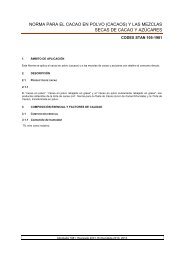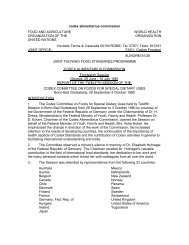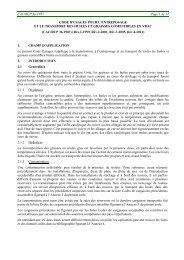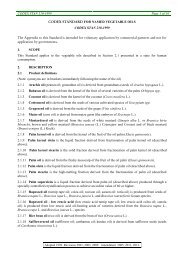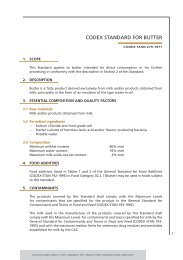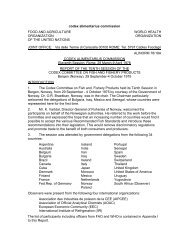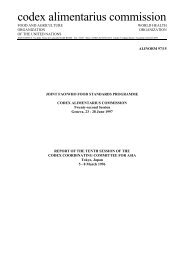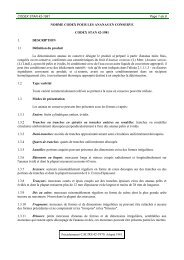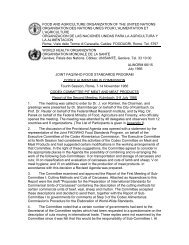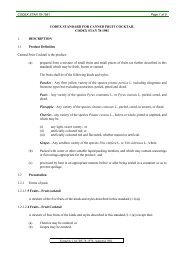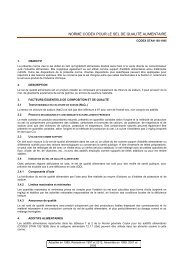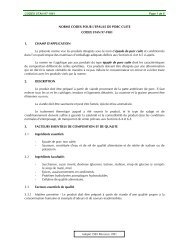REP13/FH JOINT FAO/WHO FOOD STANDARDS PROGRAMME ...
REP13/FH JOINT FAO/WHO FOOD STANDARDS PROGRAMME ...
REP13/FH JOINT FAO/WHO FOOD STANDARDS PROGRAMME ...
You also want an ePaper? Increase the reach of your titles
YUMPU automatically turns print PDFs into web optimized ePapers that Google loves.
<strong>REP13</strong>/<strong>FH</strong> Appendix III 48<br />
35. The results of testing may be impacted by compositing (i.e. pooling) of sample units prior to analysis.<br />
Compositing will affect the final concentration in the tested sample and is not appropriate for enumeration<br />
methods of analysis or within three-class sampling plans. Compositing may be considered in the case of<br />
presence/absence testing within a two-class sampling plan, as long as it is ensured that the result of testing<br />
will not be affected when compared to testing of individual analytical units.<br />
4.8 Statistical performance<br />
36. The statistical performance of a sampling plan is usually illustrated by its operating characteristic (OC)<br />
curve, which describes the probability of acceptance as a function of the actual proportion of non-conforming<br />
analytical units or concentration of the microorganisms in the food. An OC curve can be used to evaluate the<br />
influence of individual parameters of the sampling plan on the overall performance of the plan.<br />
37. Web-based tools for evaluation of sampling plans developed by <strong>FAO</strong> and <strong>WHO</strong> through JEMRA 5 or by<br />
others can be utilised to evaluate sampling plans under consideration.<br />
4.9 Moving Window<br />
38. In a moving window approach a sufficient number of sample units (n) is collected for a defined period<br />
of time (the “window”). The results of the latest n sample units are compared with the microbiological limit(s)<br />
(m, M) using the acceptance number c. Each time a new result from the sampling period is available, it is<br />
added to the window while the oldest result is removed, creating the “moving window”. This approach can<br />
also be applied to a set of results, e.g. results obtained during a week. The window, always consisting of n<br />
results, moves one result or set of results forward in time. In determining the size of the moving window<br />
consideration should be given to the combination of the production frequency and sample frequency<br />
necessary to obtain a sufficient number of results that enables appropriate verification of performance of a<br />
process or a food safety control system.<br />
39. The moving window approach is a practical and cost beneficial way of checking continuous<br />
microbiological performance of a process or a food safety control system. As in the traditional point-in-time<br />
approach commonly used in connection with microbiological criteria, the moving window determines the<br />
acceptability of the performance so that appropriate interventions can be made in case of unacceptable<br />
shifts in control.<br />
40. The length of the moving window should be appropriate to enable corrective action to be taken in a<br />
timely manner. If more than c out of n results is above the limit m, or the limit M is exceeded, then corrective<br />
action is required.<br />
41. The moving window approach should not be confused with trend analysis, which is described in the<br />
following section.<br />
4.10 Trend Analysis<br />
42. Trend analysis is a procedure to detect a change in the patterns of observations over a period of time<br />
(usually over a relatively long period of time, often not predefined). It can be applied to many types of<br />
information including results of microbiological testing against a microbiological criterion. Trend analysis can<br />
detect a gradual loss of control that might not be detected by a moving window approach, as well as a more<br />
sudden loss of control.<br />
43. Trend analysis may show changes or patterns in the data that are a result of unwanted changes in the<br />
manufacturing process enabling the food business operator to take corrective actions before the food safety<br />
control system is out of control. The trends (or patterns) can be visualized, e.g. by displaying the test results<br />
graphically.<br />
4.11 Action to be taken when the microbiological criterion is not met<br />
44. In situations of non-conformance with the microbiological criterion (unsatisfactory results), actions to<br />
be applied should include corrective actions related to the purpose of the testing. These actions should be<br />
based on an assessment of the risk to the consumer where relevant; the point in the food chain, and the food<br />
specified and may consider history of conformance. Food business operators should re-evaluate their food<br />
safety control systems, including GHP and operational procedures, and/or further investigation to determine<br />
appropriate preventative actions to be taken.<br />
45. In the event of a non-conformance with a microbiological criterion for a foodborne pathogen, actions<br />
should include appropriate product containment and disposition. This may include further processing,<br />
diversion to an alternate use, withdrawal and/or recall, rework, rejection or destruction of product, and/or<br />
5 http://www.mramodels.org/sampling/



